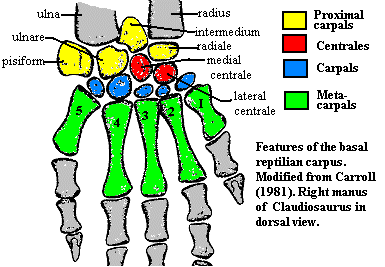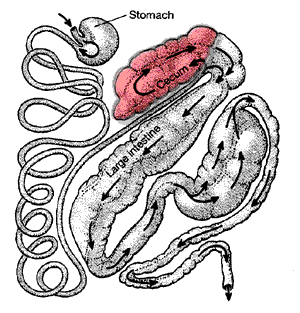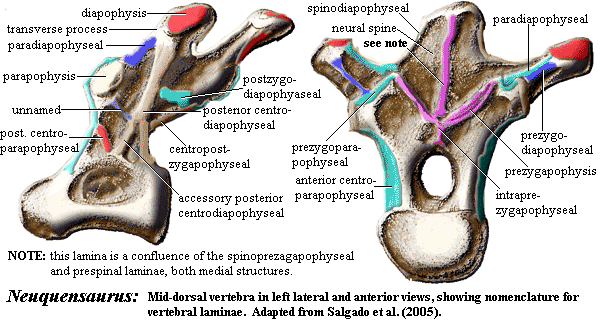| Glossary | ||
| The Vertebrates | Ca-Cg |
| Vertebrates Home | Vertebrate | Vertebrate | Bones | Timescale |
For most phrases beginning with directional words, e.g. "posterior," "dorsal," "external," etc., or some generic anatomical terms, e.g., "vena," look under the next word in the phrase. However, note that this convention is not used with complete consistency in this Glossary.
© Cambrian Period or copyright
Cthe Carboniferous Period.
C/c in mammalian dentition, an upper (C) or lower (c) canine tooth.
C-terminal The region of a protein near the end with a free carboxyl group. See N-terminal for explanation and figure.
Calamus the unbranched base of a feather.
Calcaneal tuber the "heel." The proximal or proximo-plantar portion of the calcaneum may project outward from the ankle (as in humans) and serve as an attachment for the m gastrocnemius via the Achilles tendon.
Calcaneum One of the two proximal tarsals or upper ankle bones. It is the more lateral of the two and often articulates with the fibula. Compare astragalus. See Figure at Tarsus.
Calcaneus the human calcaneum.
Calcareous made up of biogenic calcium carbonate (shells and related materials). Thus, for example, "calcareous limestone" is limestone of biogenic origin, made up of crushed fragments of shells that have solidified into rock over time and under pressure.
Calcified cartilage cartilage containing deposited calcium salts; found in the vertebrae of cartilaginous fish. Introduction to the skeletal system (comment: this is probably a weak, even incorrect, definition.)
Camber curvature of a wing.
CambrianAbbreviated '©'. The period from 543 - 490 Mya. As used here, the Early Cambrian comprises the Cambrian A epoch (543-520 Mya), Middle Cambrian comprises the Cambrian B & C epochs in North America, the Montezuman, Dyerian, Delmaran and Marjuman ages, 520-500 Mya), and the Furongian the Cambrian D epoch (the North American Steptoean and Sunwaptan ages, 500-490 Mya).
Campanian An age of the Late Cretaceous, about 83.5-71.3 Mya.
Campyl- Greek root meaning curved or bent.
Cancellate (or cancellous or cancellar) having cavities. Note for non-native English speakers or linguistic pedants of all nationalities: the suffix -ate is usually derived from the Latin passive perfect participle, thus here would carry the sense of "having had holes cut out of it." The suffix -ous is derived from a simple Latin adjectival ending and carries a purely descriptive sense ("having holes" or "characterized by having holes"), without the implication of past action to create the holes. The suffix -ar may be Greek. In any case, it should be used to mean "of, or pertaining to, holes." Obviously, the word cancellar should not be used to mean something that merely has a lot of holes, and cancellate should be reserved for describing objects that were solid, but have been hollowed out in some way. Fortunately, no one has the time or patience for this sort of nonsense, so all three words are used interchangeably.
Canine (a) of dentition, typically a single pair of elongate, pointed, recurved teeth in the anterior jaw. The term, properly speaking, applies only to therapsids. In mammals, the canines are located between the incisors and premolars. Canines are most frequently found in carnivores, many omnivores, and in particularly bellicose herbivores. See Canines. b) of or relating to dogs.
Canine buttress same as canine flange, but typically used in reference to non-mammals.
Canine flange an expanded and/or reinforced section of the maxilla (and, rarely, the dentary) in which the canines are rooted.
Caniniform of dentition, a tooth shaped like a canine, i.e., long, pointed & recurved.
Cannon bone bone created by fusion of two adjacent metapodials.
Capitate in mammal osteology, one of the distal carpals, essentially a proximal extension of Mc III. Also referred to as the magnum.
Capitellum of the humerus, the rounded structure on which the radius rotates. See Humerus.
Capitis lateralis, vena a superficial vein that drains the side of the head in mammaliforms. The VCL drains into the internal jugular after the latter leaves the braincase.
Capitulum [1] of the humerus, same as capitellum. Medical terminology used primarily for humans and other mammals. See Humerus. [2] of ribs, the more ventral of the articulations with the vertebrae.
Caput L. = head. Usually refers to a large, convex articular surface such as the head of the humerus (= caput humeri). More generally, any enlarged, rounded terminal structure to which we might apply the English term "head."
Carangiform type of undulatory locomotion in which the body inscribes less than < ½ wavelength at any one time.
Carboniferous Period (C) The penultimate period of the Paleozoic Era, 354-290 Mya. The Early Carboniferous (354-323 Mya) is known as the Mississippian in North America. Elsewhere, it is divided into the Tournasian, Viséan and Serpukhovian Ages. The North American Late Carboniferous 323- 290 Mya) is the Pennsylvanian. Elsewhere it includes the Bashkirian, Moscovian, Kasimovian and Gzhelian Ages.
Cardioid heart-shaped.
Carina L. carina = keel of a boat. (1) The medial keel of the sternum which, in birds, supports the supracoracoideus muscle and, in part, the pectoralis muscle. (2) used of several anatomical structures having a central ridge, normally a ventral ridge.
Carinate [1] of birds, having a massively enlarged sternum to support flight muscles; [2] more generally any structure bearing a "keel" or sharp, longitudinal median ridge.
Carnassial In some carnivores, one or two of the cheek teeth may be carnassials, specialized blade-like cutting teeth. La Brea Tar Pits. See Molars.
Carotid artery the major artery supplying the brain. The internal (cerebral) branch of the carotid is of special significance in anatomy because it enters the braincase through phylogenetically interesting foramina. In mammals, the internal carotid supplies the anterior part of the brain, the eye and its appendages, and sends branches to the forehead and nose. The external carotid rapidly splits into numerous branches which supply mostly external structures.
Carpal relating to the carpus (= wrist). Sometimes used to refer to all of the bones of the wrist and hand.

Carpometacarpusthe fused wrist+hand unit in birds.
Carpus the wrist. The basic features of the reptilian carpus are shown in the figure. Modified from Carroll (1981)'s figure of Claudiosaurus. Mammalian terminology is quite different. See image at unciform.
Carrier's Constraint essentially, that it is not possible to walk and chew gum. Primitively, locomotion involves lateral bending of the body so that air is pressed out of one lung at each step. Thus breathing and locomotion aren't possible at the same time. The term was coined in 1990 by Richard Cowen in his History of Life, accompanied by this limerick:
The reptilian idea of fun
Is to bask all day in the sun
A physiological barrier,
Discovered by Carrier,
Says they can’t breathe if they run.
R. Cowen, The History of Life
Several lines of organisms have engineered around this constraint. Many archosaurs did so by developing bipedal locomotion, thus decoupling walking from breathing. Mammals developed a diaphragm and undulation in the vertical plane with the same effect. The original cite is Carrier, DR (1987), The evolution of locomotor stamina in tetrapods: circumventing a mechanical constraint. Paleobiology 13: 326-341. More information can be found here.
Cartilage firm but elastic skeletal tissue whose matrix contains chondroitin sulfate and collagen or elastic protein (fibers) and is generally not vascularized. Cartilage typically contains considerable tightly-bound water. The cellular elements of cartilage are called chondrocytes which lie in spaces called lacunae surrounded by the perichondrium, fibrous connective tissue that lies on the outside of cartilaginous tissue. Structurally, cartilage is incompressible, highly flexible, but not ductile (that is, it returns to its original form). May be found in several forms (ranked from least dense to most dense): Hyaline, elastic, fibrocartilage and calcified cartilage (q.v.). Introduction to the skeletal system.
Casamayoran Age South American Land Mammal Age traditionally thought to correspond to the Early Eocene. Recent work suggests a significantly later age -- Middle or Late Eocene.
Caudad a really effete and obnoxious adverb of direction, meaning towards the tail, or (almost always) posteriorly. Opposite of "cephalad," "rostrally," or "anteriorly." In the late 1990's and early 2000's, the caudad-cephalad terminology was considered trendy. However, it met considerable resistance from sensible people and is hopefully on on its way out (or cloacad).
Caudal (1) as a direction, towards the tail, i.e., posterior; 2) of, or relating to, the tail; (3) as a noun, a tail vertebra.
Caudofemoralis a muscle which originates on the tail and inserts on the fourth trochanter of archosaurs and is active in retraction of the limb during stance phase.
Cavum conchae See concha and Ethmoid.
Cavum epiptericum "a large primitively extracranial space situated lateral to the sidewall of the orbitotemporal region of the skull. The space contains the post-trigeminal ganglion, primary head vein and several nerves (ophthalmic, oculomotor, trochlear, maxillary, mandibular and abducent)" Reconstruction of the petrosal in Late Cretaceous multituberculates (Mammalia). In therian mammals, the medial wall of the cavum, formed by the pila antotica (q.v.) is lost and the cavum is bounded laterally by the alisphenoid. It is thus incorporated into the braincase. Curiously mutations in certain retinoic acid receptors can recreate something rather similar to the primitive condition. Lohnes et al. (1994).

Cecum a blind pouch or pocket, such as an alveolus in the lung. In particular, the cecum refers to a blind pocket in the gut used by non-ruminants to cultivate bacteria which digest cellulose. This is so-called "hind-gut" fermentation. Image from Prothero & Schoch (2002).
Cedar Mountain Formation Cretaceous (Early Cretaceous to Late Cretaceous), of western Colorado & eastern Utah. According to Head (2001), late Albian & early Cenomanian. According to Cifelli & Madsden (1998), Barremian to Cenomanian. Various iguanodontians & hadrosaurids, multituberculates, triconodontids & Kokopellia (an early tribosphenid). The Cedar Mountain Formation has two principal members: the Buckhorn Conglomerate (lower) and an unnamed shale member (upper). Both are terrestrial in origin. The Cedar Mountain unconformably overlies the Morrison Formation and underlies the Late Cretaceous Dakota Formation.
Cenomanian The first age of the Late Cretaceous, about 99.0-93.5 Mya.
Cenozoic Era the present era (65-0 Mya). The Cenozoic is carved up in an irritating number of different ways. Instead of Periods, it has Epochs: the Paleocene, Eocene, Oligocene, Miocene, Pliocene, Pleistocene and Holocene Epochs. Each of the epochs has one or more Ages attached to it. However, these Ages don't get as much exercise as Mesozoic Ages because they often refer to a single subdivision. That is, for example, the Ypresian 54.8-49.0 Mya) is the same as the Early Eocene. The Paleocene, Eocene and Oligocene are collectively referred to as the Paleogene, while the Miocene, Pliocene, Pleistocene and Holocene are known as the Neogene. The Tertiary means everything except the Pleistocene and Holocene, which are collectively the Quaternary. Finally, the Recent refers to approximately the last thousand years.
Center of mass For purposes of analyzing momentum, torque, and balance, a body can often be treated as dimensionless point of identical mass located at a position referred to as the center of mass or, more colloquially, the center of gravity. Imagine that the body is divided into a very large number of tiny pieces. Assign each piece a position on a coordinate grid. Multiply the mass of each piece by its x, y, and z coordinates (i.e., mx + my + mz). Add everything up. If the origin of the grid (the point 0, 0, 0) is the center of mass, and the pieces are infinitely small, the result is zero. (This is calculus. Don't try it on your hamster). In a gravity field, this point is the center of gravity and can be compactly defined as the point at which net torque is zero. Operationally, although less accurately, the center of gravity is the point (there's only one) at which the body would balance, no matter how you chose to orient the body.

Centrodiapophyseal lamina reinforcing ridge bone ridge in the vertebrae (normally, of sauropods) connecting the centrum and the diapophyses. Anterior, posterior, and/or accessory lamina may be present, as in the image.
Centroparapophyseal lamina reinforcing ridge bone ridge in the vertebrae (normally, of sauropods) connecting the centrum and the parapophyses. Anterior, posterior, and/or accessory lamina may be present, as in the image.
Centropostzygapophyseal lamina reinforcing ridge bone ridge in the vertebrae (normally, of sauropods) connecting the centrum with one of the postzygapophyses.
Centroprezygapophyseal lamina reinforcing ridge bone ridge in the vertebrae (normally, of sauropods) connecting the centrum with one of the prezygapophyses.
Centrum(-a)the central portion of the vertebra, which in early vertebrates, was taken up by the notochord. In derived forms, the centrum becomes ossified. See diagram at diapophysis.
Ceratal referring to the more ventral of the two main elements of a gill arch, i.e. the ceratobranchials, the ceratohyal, and/or Meckel's Cartilage. See Gill Arches.
Cerato- prefix referring to a ceratal element. See Gill Arches.
Ceratobranchial the more ventral of the two main elements of a gill arch. Serial homologues of Meckel's Cartilage and the ceratohyal. See Gill Arches.
Ceratohyal in fishes, the ventral or ceratal main element of the hyoid arch. See Gill Arches.
Ceratotrichia fin support structures which are primarily made of keratin, rather than bone. Ceratotrichia may replace fin radials, or simply act as a third level of support (i.e. basals -> radials -> ceratotrichia).
Cervical [1] relating to the neck. As a noun, the cervical vertebrae. [2] of mammalian dentition, towards the root.
checked ATW050803